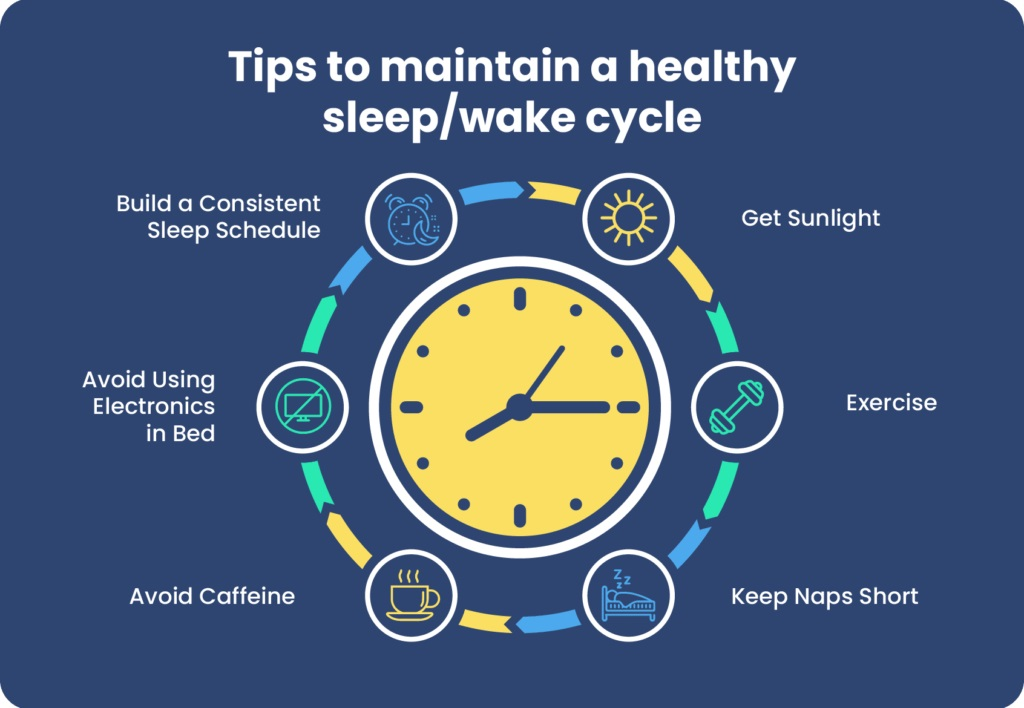In the intricate dance between day and night, our bodies follow a natural rhythm known as the circadian cycle. Understanding the profound influence of these “Rhythms of Rest” is key to unlocking the secrets of optimal sleep health. This article explores the science behind circadian rhythms, their impact on sleep, and how aligning with these innate patterns can lead to a more restful and rejuvenating slumber.

- Circadian Symphony: The Body’s Internal Timekeeper
Unveiling the conductor of our internal orchestra, this section introduces the circadian rhythm as the body’s master timekeeper. It explores how this intricate symphony orchestrates a series of physiological processes over a 24-hour period, influencing everything from hormone release to body temperature.
- The Light-Dark Ballet: Mastering External Cues
Delving into the external cues that govern circadian rhythms, this part investigates the pivotal role of light and darkness. It explores how exposure to natural light during the day and darkness at night helps synchronize our internal clocks with the external world.
- Circadian Harmony and Sleep: The Nighttime Sonata
Shifting focus to the nighttime movement of the circadian symphony, this section explores the natural ebb and flow that prepares the body for sleep. It discusses the release of the sleep-inducing hormone melatonin and the gradual reduction of body temperature as key elements of the nocturnal sonata.
- The Jet Lag Tango: Disruptions to Circadian Rhythms
Acknowledging the challenges posed by disruptions such as jet lag, this part discusses how changes in time zones can temporarily throw circadian rhythms out of sync. Strategies for mitigating the impact of jet lag and restoring harmony to the circadian dance are explored.
- Circadian Influences on Sleep Architecture
Investigating how circadian rhythms shape the architecture of sleep, this segment explores the ideal times for falling asleep, experiencing deep sleep, and entering the REM stage. It emphasizes the importance of aligning sleep patterns with the body’s natural cycles for optimal sleep quality.
- Shift Work Dilemma: Navigating Circadian Challenges
Addressing the unique challenges faced by shift workers, this part discusses the impact of irregular work hours on circadian rhythms. It offers strategies for mitigating the negative effects and promoting better sleep health in occupations with non-traditional schedules.
- The Circadian Reset: Strategies for Optimization
Transitioning into practical insights, this section provides strategies for resetting and optimizing circadian rhythms. It explores the role of consistent sleep schedules, exposure to natural light, and the importance of maintaining a circadian-friendly lifestyle for overall sleep health.
- Leveraging Circadian Rhythms for Better Sleep Habits
Concluding the discussion, this segment offers actionable tips for leveraging circadian rhythms to establish healthy sleep habits. It encourages individuals to embrace the natural ebb and flow of the circadian dance for a more harmonious and restful night’s sleep.
Conclusion:
As we navigate the intricate “Rhythms of Rest,” let us recognize the inherent wisdom of our circadian cycles. By aligning with these natural patterns, we can cultivate sleep habits that resonate with the body’s internal symphony, leading to nights of restful and rejuvenating slumber. May our understanding of circadian rhythms serve as a guide on the journey to optimal sleep health.
- Circadian Symphony: The Body’s Internal Timekeeper
Unveiling the conductor of our internal orchestra, this section introduces the circadian rhythm as the body’s master timekeeper. It explores how this intricate symphony orchestrates a series of physiological processes over a 24-hour period, influencing everything from hormone release to body temperature.
- The Light-Dark Ballet: Mastering External Cues
Delving into the external cues that govern circadian rhythms, this part investigates the pivotal role of light and darkness. It explores how exposure to natural light during the day and darkness at night helps synchronize our internal clocks with the external world.
- Circadian Harmony and Sleep: The Nighttime Sonata
Shifting focus to the nighttime movement of the circadian symphony, this section explores the natural ebb and flow that prepares the body for sleep. It discusses the release of the sleep-inducing hormone melatonin and the gradual reduction of body temperature as key elements of the nocturnal sonata.
- The Jet Lag Tango: Disruptions to Circadian Rhythms
Acknowledging the challenges posed by disruptions such as jet lag, this part discusses how changes in time zones can temporarily throw circadian rhythms out of sync. Strategies for mitigating the impact of jet lag and restoring harmony to the circadian dance are explored.
- Circadian Influences on Sleep Architecture
Investigating how circadian rhythms shape the architecture of sleep, this segment explores the ideal times for falling asleep, experiencing deep sleep, and entering the REM stage. It emphasizes the importance of aligning sleep patterns with the body’s natural cycles for optimal sleep quality.
- Shift Work Dilemma: Navigating Circadian Challenges
Addressing the unique challenges faced by shift workers, this part discusses the impact of irregular work hours on circadian rhythms. It offers strategies for mitigating the negative effects and promoting better sleep health in occupations with non-traditional schedules.
- The Circadian Reset: Strategies for Optimization
Transitioning into practical insights, this section provides strategies for resetting and optimizing circadian rhythms. It explores the role of consistent sleep schedules, exposure to natural light, and the importance of maintaining a circadian-friendly lifestyle for overall sleep health.
- Leveraging Circadian Rhythms for Better Sleep Habits
Concluding the discussion, this segment offers actionable tips for leveraging circadian rhythms to establish healthy sleep habits. It encourages individuals to embrace the natural ebb and flow of the circadian dance for a more harmonious and restful night’s sleep.
Conclusion:
As we navigate the intricate “Rhythms of Rest,” let us recognize the inherent wisdom of our circadian cycles. By aligning with these natural patterns, we can cultivate sleep habits that resonate with the body’s internal symphony, leading to nights of restful and rejuvenating slumber. May our understanding of circadian rhythms serve as a guide on the journey to optimal sleep health. ()





